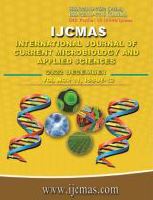


 National Academy of Agricultural Sciences (NAAS)
National Academy of Agricultural Sciences (NAAS)

|
PRINT ISSN : 2319-7692
Online ISSN : 2319-7706 Issues : 12 per year Publisher : Excellent Publishers Email : editorijcmas@gmail.com / submit@ijcmas.com Editor-in-chief: Dr.M.Prakash Index Copernicus ICV 2018: 95.39 NAAS RATING 2020: 5.38 |
Pollution is a pervasive phenomenon and inconvenient truth. Effluents from domestic and industrial sources are being released into the water bodies. They not only pollute the water bodies but also disturb the normal biological cycles of associated organisms. Industrial effluents are more polluting in nature as compared to domestic effluents. Industries utilize humongous quantities of water for cooling, cleaning, transportation and other tasks. In the process the water interacts with different chemicals, some are toxic while some may be neutral. It forms a harmful effluent and when it is disposed of in water bodies, causes water pollution. Wastewater from the brewery, tannery, paper pulp industries, food industries and textile industries are rich in organic contaminants. Removal of degradation of these contaminants is quite important before their disposal into water bodies. Various methods are available for effective removal of these contaminants from the effluents namely physical, chemical & biological. Biological treatment involves both aerobic & anaerobic treatment as well as degradation with microbes. Microbes contain several enzymes that can effectively degrade different organic compounds. Tannase isolated from some fungal and bacterial strains is effective in the degradation of tannin present in the effluent from the leather industry.
 |
 |
 |
 |
 |